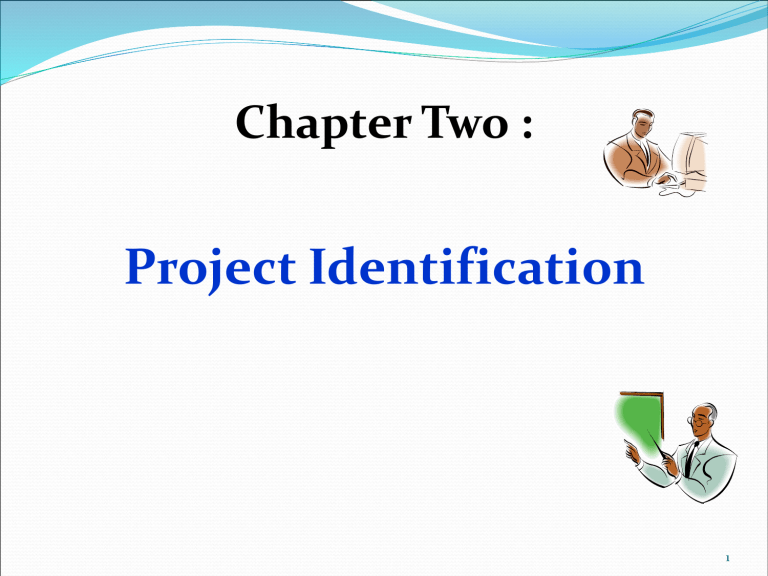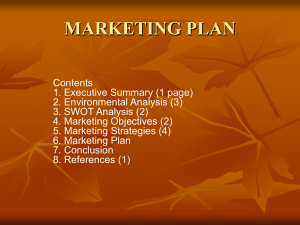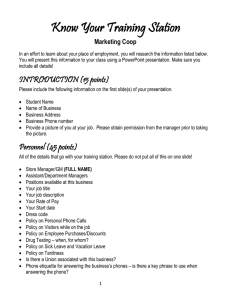
Chapter Two : Project Identification 1 Contents • Conceptual Clarification • Sources of project ideas • Steps in Project Identification and Selection Situation analysis Stakeholders analysis SWOT analysis Problem analysis Objective analysis Alternative Tree Analysis or Project Selection Group Exercise Chapter objectives: At the end this chapter, You will be able to: • identify feasible project ideas to solve a certain problem or exploit opportunities, and • apply different tools [problem tree] in project identification and selection. 2.1. Project Identification-meaning - It involves the conceiving of ideas or intentions to set up a project. - These ideas are then transformed into a project. Project ideas are normally initiated by a perceived need [PROBLEM or OPPORTUNITY] in an organization and converted in to a formal project proposal. Project Identification-meaning The major focus in this step is finding project ideas or identifying needs or demands for projects. The activities carried out are generally fact-finding survey, or review of census or available secondary data. Group Discussion What are the sources for project ideas? Categorize into Macro and micro sources 2.2. Sources of project ideas: The community, researchers, experts, local leaders, Policy makers, entrepreneurs, donors, NGOs, Planners, etc. Government policy priorities, unusual events, external threats, unsatisfied demands, under utilized natural resources, etc. The business or government development planning document Needs of clients Individual working in organizations, well informed technical specialists Local leaders Government departments, Other country's experiences Various Chambers of Commerce and Industry National Small Industries Corporation, and several other institutions including the business press, They regularly publish valuable data and analytical reports about the trends of demand, supply, costs in various segments of industry and business. Sources of project ideas _Cont’d By their very nature, opportunity studies are indicative rather than detailed and hence are generally based on macro-parameters and rough estimates. Such studies may also be carried out in one of the following three directions: a given geographical area (Area studies). a specific sub-sector of economy or industry, like food- processing, agriculture, or power generation (Sub-sectorial studies). exploitation of renewable and non-renewable natural, agricultural, or industrial produce like minerals, sugarcane, flash, fish, plants, and even geothermal energy sources, etc. (Resource-based studies). Sources of project ideas _Cont’d Opportunity study: Objectives: REFINEMENT OF BUSINESS IDEA PRELIMINARY EVALUATION OF ALTERNATIVE APPROACHES PRELIMINARY ASSESSMENT OF STRENGTHS AND WEAKNESSES OF CONCEPT Characteristics: SKETCHY, BASED MORE ON ROUGH AGGREGATE ESTIMATES THAN ON DETAILED ANALYSIS Who identifies projects? Various organizations, whether local or foreign, state owned or private, government ministries, development banks, interest groups, CBOs, NGOs and of course individuals can identify projects. Approaches to project identification There are two major approaches to project identification : (a) Top-down approach (b) Bottom-up approach Top-Down Approach Projects are identified based on demands from beyond the community. This may include directives from: international conventions (such as Kyoto Protocol/climate change) international institutions that have determined particular priorities and thus projects national policy makers identifying projects that pertain to party manifestos and/or national plans. Advantages of Top-Down Approach It may be a rapid response to disasters like floods, war outbreak because there is limited time and chance to consult the beneficiaries. It can be effective in providing important services like education, health, water, roads etc. It can contribute to wider national or international objectives and goals Limitations of Top-Down Approach Does not help in modifying strongly established ideas and beliefs of people. Assumes external individuals know better than the beneficiaries of the service. Communities have little say in planning process rendering approach devoid of human resource development. Community develops dependency syndrome on outside assistance and does not exploit their own potential. Bottom-Up Approach In this approach community/ beneficiaries are encouraged to identify and plan the projects themselves with or without outsiders. Advantages of Bottom-Up Approach Interveners accomplish more with limited resources since people tend to safeguard what they have provided for themselves. Develops people’s capacity to identify problems and needs and to seek possible solutions to them. Provides opportunities of educating people. Helps people to work as a team and develop a “WE” attitude - makes project progressive and sustainable. Resources are effectively managed; dependence reduces, there is increased equity, initiative, accountability. Limitations of Bottom-Up Approach Not always effective for projects that require urgency to implement Time-consuming and requires patience and tolerance. People sometimes dislike approach because they do not want to take responsibility for action. The agency using this approach is never in control and cannot guarantee the results it would want. The priorities of communities may not fit with national or international priorities that seek to have a broader impact. Project Identification in Both approaches: Involves needs assessment - collecting, processing and analyzing data on problems/needs of communities Review of secondary data - Look at books, survey reports/ research papers, publications, media reports, internet etc. Collecting and analyzing primary information • Interviews • Community mapping • Focus Group Discussions • Other methods 2.3. Activities (Steps) in Project identification and initial screening: Situation analysis Stakeholders analysis SWOT analysis Problem analysis Objective analysis Alternative Tree Analysis or project selection a) Situation analysis This is about describing the problem or situation to be addressed by the project. This can be ‘problem based’ or ‘opportunity based’. e.g. what are the prevalent problem situations or ‘opportunity based’, e.g. is there an opportunity to serve people with disability? Or is there an opportunity to establish a Cement Factory (suitable soil) The information source is basically a status quo report from the strategic planning process. It could also be a status quo report from a feasibility study, a pre-appraisal report. B. Stakeholder Analysis Stakeholder is any individual, group or organization, community, with an interest in the outcome of a programme/project. Key Question Whose problems or opportunities are we analyzing? Who will benefit or loose-out, and how, from a potential project intervention? 21 Stakeholder Analysis _ Cont’d Purpose: To identify: Needs and interest of stakeholders Organizations and groups that should be encouraged to participate in different stages of the project Potential risks that could put at risk programme Opportunities in implementing a programme 22 Stakeholder Analysis-Cont’d Execise 1 Let us list up the stakeholders for primary education (more than 50) Exercise 2 Let us categorize them beneficiaries/negatively affected groups/decision makers/funding agencies/community leaders/potential opponents/supporting group Exercise 3 Let us set the target group 23 C. SWOT Analysis-Cont’d SWOT analysis is a tool for institutional appraisal and a brainstorming exercise in which the representatives of the organization participate fully. Strengths SWOT stands for: Weaknesses Opportunities Threats 24 SWOT Analysis _Cont’d Strengths - the positive internal attributes of the organisation Weaknesses - the negative internal attributes of the organisation 25 SWOT Analysis-Cont’d Opportunities - external factors which could improve the organisation’s prospects Threats - external factors which could undermine the organisation’s prospects 26 SWOT Analysis-Cont’d Example: Vehicle Company M Strength Accumulated high technology Motivated young staff Global network to distribute Cost efficiency manufacture Opportunity Huge market in the country More global cooperation Low oil price Weakness Slow decision making Old fashioned style Weaker after-care Weaker brand images Threat High material price Foreign exchange Other competitive companies Political interference 27 D. Problem Analysis Problems Analysis visually represents the causes and effects of existing problems in the project area, in the form of a Problem Tree. It clarifies the relationships among the identified problems. 28 Problem Analysis-Cont’d Relationships of Problems? Simply connect causes and effects by directly “Because” EFFECT I am not motivated to work I am not sure what to do in this work I am lack of expertise/skills CAUSE I am lack of training My salary is low My company is not getting profit My post is not high yet I get poor respect from the boss My poor communi cation to boss We have different ways to think 29 Problem Tree EFFECT CAUSE 30 Problem Analysis-Cont’d Steps in Undertaking Problem Tree 1. 2. 3. Identify problems that the project will address. State problems in negative manner. Group problems by similarity of concerns. Develop the problem tree: a) b) c) Select a Core/Focal problem from the list and relate other problems to the core/focal problem. If the problem is a cause of the core problem the tree is placed below the core problem If the problem is an effect of the core problem is goes above 31 Problem Analysis-Cont’d 32 E. Objective Analysis Objective Analysis clarifies the means-ends relationship between the desirable situation that would be attained and the solution for attaining it. This stage also requires an Objective Tree. This involves turning a problem tree into an objectives tree 33 F. Project Selection/ Analysis of alternatives. Project Selection is a process in which specific project strategies are selected from among the objectives and means raised in Objectives Analysis, based upon selection criteria. 34 Project Selection _ cont’d How to select the project 1. Divide the objective tree into different clusters of objectives 2. Name all clusters 3. Remove impossible one to achieve 4. Set criteria to make the final selection Needs, Priority, Gender, Environment, Difficulty, Budget, Risks, etc,,,, 35 Analysis of alternatives. At this stage, there is a need to assess the alternative courses of action proposed by each objective tree in terms of effectiveness, costs, feasibility, impact on priority groups, risks or other criteria. Criteria can be: Technical Financial Economic Institutional Social/distributional Environmental Preliminary screening Once some project ideas have been put forward, the next step will be to select one or more of them as a potentially viable. This requires a quick preliminary screening by experienced professionals. At this stage, the screening criteria are vague and rough During this stage, the analysts should eliminate project proposals that are: Technically unsound & risky Projects that have no market for their outputs Have inadequate supply of inputs Very costly in relation to benefits Assume over ambitious sales and profitability 37 Mortality of new project ideas Appraisal No. of ideas Screening Selection Time 38 Term paper I (50%)-Project Proposal development Identify as many project ideas as possible in one of your group members’ organization. Note that follow all steps involved in project cycle stage. Submission date: on or before one week of the final exam 39 End of Chapter Two 40

